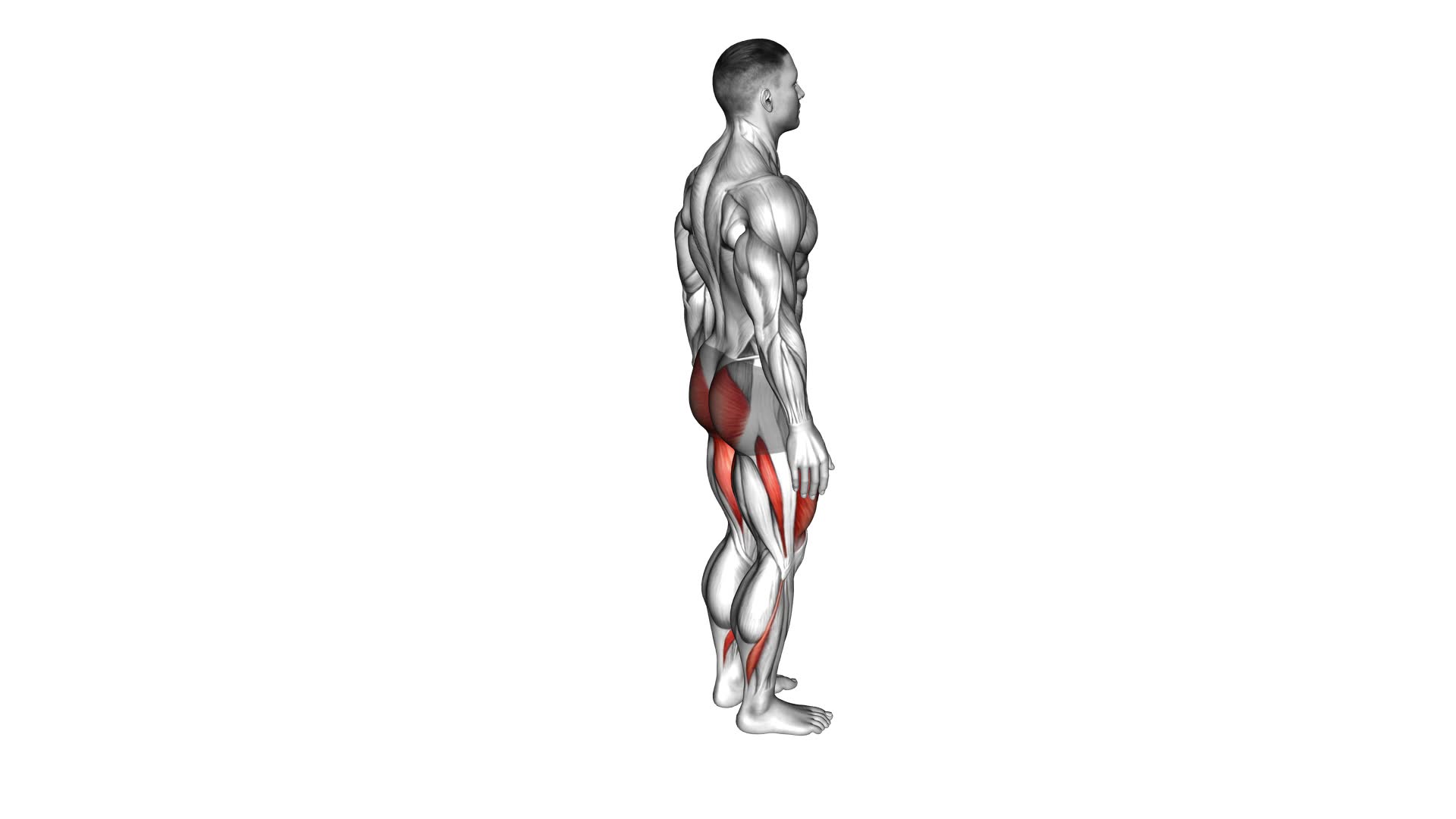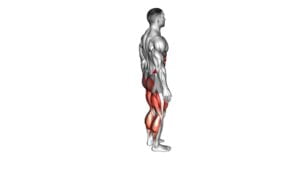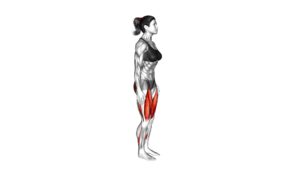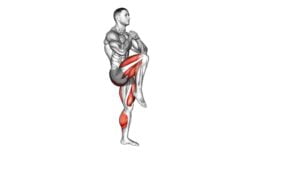Reverse Lunge (Leg Kick) (Male) – Video Exercise Guide & Tips

Looking to add a new exercise to your workout routine? Check out the Reverse Lunge (Leg Kick).
Watch This Exercise Video
This video exercise guide and tips will show you how to perform the move correctly, while also providing modifications and progressions.
Avoid common mistakes and make the most of this exercise for strengthening your legs and improving balance.
Get ready to kick your fitness goals into high gear with the Reverse Lunge (Leg Kick)!
Key Takeaways
- The reverse lunge (leg kick) improves leg strength, balance, and activates muscles in the lower body.
- It enhances balance and stability by challenging core, hip, and ankle stabilization muscles.
- The exercise can be beneficial for daily activities and sports.
- Proper form and technique, such as maintaining balance and engaging core muscles, are important for maximizing the benefits of the exercise.
Benefits of the Reverse Lunge (Leg Kick)
Improve your leg strength and balance with the reverse lunge (leg kick). This exercise provides numerous benefits for muscle activation, balance, and stability.
By incorporating the reverse lunge (leg kick) into your workout routine, you engage various muscles throughout your lower body, including your quadriceps, hamstrings, glutes, and calves. The movement required to perform the exercise activates these muscles, helping to strengthen and tone them.
Additionally, the reverse lunge (leg kick) enhances your balance and stability. As you step back into the lunge position and then kick your leg forward, you challenge the stabilization muscles in your core, hips, and ankles. This helps to improve your overall balance and coordination, which can be beneficial in various daily activities and sports.
By regularly incorporating the reverse lunge (leg kick) into your exercise routine, you can effectively target and strengthen your leg muscles while also improving your balance and stability.
Remember to maintain proper form throughout the exercise, keeping your core engaged and your movements controlled. As with any exercise, start with lighter weights or no weights at all, and gradually increase the intensity as you become more comfortable and confident.
Proper Form and Technique
To perform the reverse lunge (leg kick) with proper form and technique, step back into a lunge position and then kick your leg forward while engaging your core and maintaining control throughout the movement. Here are some key points to keep in mind:
- Maintain balance: Keep your weight evenly distributed between your front and back legs to prevent leaning too far forward or backward.
- Focus on stability: Engage your core muscles to stabilize your body during the movement, helping you maintain control and prevent wobbling.
- Control the kick: As you kick your leg forward, avoid swinging it wildly. Instead, use controlled movements to target your leg muscles effectively.
- Full range of motion: Ensure that you step far enough back into the lunge position to allow for a complete leg kick. This will help you maximize the benefits of the exercise.
Now that you know the proper form and technique for the reverse lunge (leg kick), it's important to be aware of common misconceptions, variations, and alternatives. Understanding these aspects can help you tailor the exercise to your specific needs and goals.
But before we delve into that, let's first discuss some common mistakes to avoid when performing this exercise.
Common Mistakes to Avoid
When performing the reverse lunge (leg kick), it's important to be mindful of common mistakes to avoid. By being aware of these mistakes, you can ensure proper form and technique, and avoid potential injury.
One common mistake is allowing the front knee to extend beyond the toes during the lunge. This puts excessive strain on the knee joint and can lead to discomfort or injury. To avoid this, focus on keeping the front knee aligned with the ankle throughout the movement.
Another mistake to watch out for is collapsing the upper body forward or rounding the shoulders. This can compromise your balance and stability. Instead, maintain an upright posture and engage your core muscles to provide stability.
Additionally, be cautious of not fully extending the leg during the kick. This can strain the hamstring muscles and lead to discomfort. Instead, aim for a controlled kick, keeping the leg at a comfortable height.
Modifications and Progressions
To enhance your reverse lunge (leg kick) exercise, consider incorporating modifications and progressions. By making these adjustments, you can challenge your muscles in new ways and continue to improve your strength and stability. Here are four variations to try:
- Weighted Reverse Lunge: Hold dumbbells in each hand or a barbell across your shoulders to add resistance and increase the intensity of the exercise.
- Plyometric Reverse Lunge: Instead of simply stepping back into the lunge, explosively jump off your front foot and switch legs mid-air. This modification will elevate your heart rate and enhance power and agility.
- Front Kick Reverse Lunge: After performing the reverse lunge, add a front kick with the same leg before returning to the starting position. This variation engages your core and targets your hip flexors.
- Side Lunge to Reverse Lunge: Start with a side lunge, then transition into a reverse lunge on the same leg. This progression challenges your balance and coordination while activating different muscle groups.
Remember to choose modifications and variations that align with your fitness level and goals. Gradually increase the difficulty as you become more comfortable.
Tips for Incorporating the Reverse Lunge (Leg Kick) Into Your Workout Routine
To effectively incorporate the reverse lunge (leg kick) into your workout routine, focus on maintaining proper form and gradually increasing the difficulty of the exercise. One way to do this is by incorporating variations and combinations for a full lower body workout.
For example, you can perform reverse lunges with dumbbells or kettlebells to add resistance and challenge your muscles even more. Another option is to try alternating reverse lunges with other exercises like squats or step-ups to engage different muscle groups and keep your routine interesting.
To further increase the intensity of the reverse lunge (leg kick), you can also try adding resistance bands or ankle weights. These tools will provide additional resistance and help to strengthen your muscles even more. Additionally, you can increase the number of repetitions or sets you perform, or even add a jump to the exercise to make it more challenging.
Remember to always listen to your body and start with a weight or resistance that feels comfortable for you. As you become more comfortable with the exercise, gradually increase the weight or resistance to continue challenging yourself and making progress.
Frequently Asked Questions
How Many Calories Does the Reverse Lunge (Leg Kick) Exercise Burn?
The reverse lunge (leg kick) exercise can help you burn calories. The exact number of calories burned depends on factors like your weight and intensity level. However, engaging in variations of the reverse lunge (leg kick) exercises can increase the calorie burn.
These variations can include adding weights, increasing the range of motion, or incorporating jumps. Remember to always consult with a fitness professional before starting any new exercise routine.
Can the Reverse Lunge (Leg Kick) Help Improve Balance and Stability?
Yes, the reverse lunge (leg kick) can help improve your balance and stability.
By incorporating this exercise into your workout routine, you aren't only increasing your lower body strength but also improving coordination.
The reverse lunge (leg kick) targets multiple muscle groups, including your quads, glutes, and hamstrings, which play a significant role in maintaining balance and stability.
It's an effective exercise for enhancing overall body strength and stability.
Is the Reverse Lunge (Leg Kick) Suitable for People With Knee Pain or Injuries?
The reverse lunge (leg kick) can be a beneficial exercise for improving balance and stability. However, if you have knee pain or injuries, modifications may be necessary.
It's important to listen to your body and consult with a healthcare professional or a qualified fitness trainer for guidance.
The reverse lunge can help strengthen the muscles around the knee and improve stability, but it's crucial to find alternative variations or reduce the range of motion to avoid exacerbating any knee pain or injuries.
How Often Should the Reverse Lunge (Leg Kick) Be Performed to See Results?
To see the best results with the reverse lunge (leg kick), it's important to consider frequency and duration.
How often you should perform this exercise depends on your fitness level and goals. Generally, incorporating reverse lunges into your workouts 2-3 times a week is recommended.
Aim for a duration of 10-15 minutes per session. Remember to listen to your body and adjust the frequency and duration as needed to avoid overexertion or injury.
Can the Reverse Lunge (Leg Kick) Help to Strengthen the Glutes and Hamstrings?
The reverse lunge (leg kick) is a great exercise for strengthening your glutes and hamstrings. By incorporating this exercise into your routine, you can see significant improvements in these muscle groups.
To ensure you get the most out of this exercise, it's important to focus on proper form. Keep your chest up, step back with one leg, and lower your body until your front knee is at a 90-degree angle. Repeat on the other leg for a balanced workout.
Conclusion
Incorporating the reverse lunge (leg kick) into your workout routine can provide numerous benefits. This exercise is known for strengthening your leg muscles and improving balance and stability. To maximize the effectiveness of this exercise, it is important to follow proper form and technique. This includes avoiding common mistakes that can hinder your progress. Additionally, making modifications or progressions as needed can help you challenge yourself and continue to see results. Remember to consult a professional before starting any new exercise routine, and always listen to your body to prevent injury.

Author
Years ago, the spark of my life’s passion ignited in my mind the moment I stepped into the local gym for the first time. The inaugural bead of perspiration, the initial endeavor, the very first surge of endorphins, and a sense of pride that washed over me post-workout marked the beginning of my deep-seated interest in strength sports, fitness, and sports nutrition. This very curiosity blossomed rapidly into a profound fascination, propelling me to earn a Master’s degree in Physical Education from the Academy of Physical Education in Krakow, followed by a Sports Manager diploma from the Jagiellonian University. My journey of growth led me to gain more specialized qualifications, such as being a certified personal trainer with a focus on sports dietetics, a lifeguard, and an instructor for wellness and corrective gymnastics. Theoretical knowledge paired seamlessly with practical experience, reinforcing my belief that the transformation of individuals under my guidance was also a reflection of my personal growth. This belief holds true even today. Each day, I strive to push the boundaries and explore new realms. These realms gently elevate me to greater heights. The unique combination of passion for my field and the continuous quest for growth fuels my drive to break new ground.







